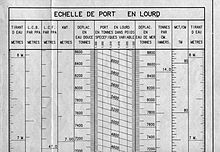Deadweight tonnage


Deadweight tonnage (also known as deadweight; abbreviated to DWT, D.W.T., d.w.t., or dwt) or tons deadweight (DWT) is a measure of how much
DWT is often used to specify a ship's maximum permissible deadweight (i.e. when it is fully loaded so that its
Plimsoll line
is at water level), although it may also denote the actual DWT of a ship not loaded to capacity.
Definition
Deadweight tonnage is a measure of a vessel's weight carrying capacity, not including the empty weight of the ship. It is distinct from the displacement (weight of water displaced), which includes the ship's own weight, or the volumetric measures of gross tonnage or net tonnage (and the legacy measures gross register tonnage and net register tonnage).
Deadweight tonnage was historically expressed in
See also
Notes
- ^ One long ton (LT) is 2,240 pounds (1,016 kg)
References
- ^ ISBN 0-87033-056-X.
- ISBN 0-87033-549-9.
- ISBN 0-87021-388-1.
- ISBN 9780080919539. Retrieved 2014-08-25.
- ISBN 978-92-801-1505-5.
- ISBN 978-92-801-1532-1.
